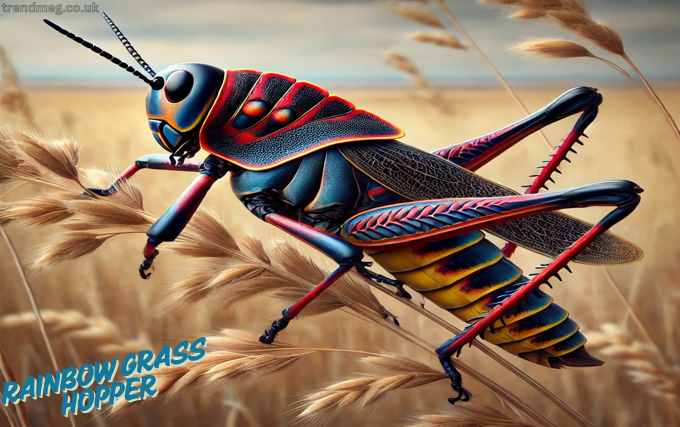The natural world is filled with remarkable creatures, each uniquely adapted to its environment. Among them, the rainbow grasshopper (Dactylotum bicolor) stands out due to its vivid coloration and striking appearance. Found primarily in North America, this species is not only a marvel to behold but also an interesting subject for scientific study due to its unique biological traits and ecological role.
This article explores the rainbow grasshopper’s habitat, physical characteristics, behavior, diet, and its importance in the ecosystem. We’ll also discuss why this insect is brightly colored and how it has adapted to its surroundings over time.
Physical Characteristics of the Rainbow Grasshopper
One of the most distinguishing features of the rainbow grasshopper is its brightly colored exoskeleton. Unlike other grasshoppers that tend to blend into their environment, the rainbow grasshopper sports a striking combination of colors, including:
- Black (often forming a base color for the body)
- Red or orange (typically seen on the legs and sometimes parts of the body)
- Yellow or green (appearing as stripes or accents along the body)
This remarkable coloration is not just for show—it serves a crucial purpose in aposematic signaling, a form of warning coloration used to deter predators by signaling toxicity or foul taste.
Habitat and Distribution
The rainbow grasshopper is predominantly found in North America, especially in the western and central regions of the United States, as well as parts of Mexico and Canada. It prefers dry, open habitats, such as:
- Grasslands
- Prairies
- Desert edges
- Roadside meadows
Unlike other grasshopper species that thrive in lush environments, the rainbow grasshopper is well adapted to arid conditions, making it a common sight in semi-arid regions with sparse vegetation.
Diet and Feeding Habits
The rainbow grasshopper is primarily herbivorous, feeding on various plant species. However, it has a particular preference for milkweed and other toxic plants, which contributes to its own defense mechanisms. Some of its common food sources include:
- Milkweed (Asclepias spp.)
- Sagebrush
- Desert-adapted plants
By consuming toxic plants, the rainbow grasshopper accumulates defensive chemicals in its body, making it unpalatable to potential predators such as birds and small mammals.
Behavior and Life Cycle
Mating and Reproduction
Rainbow grasshoppers have a fascinating reproductive cycle. Their mating season occurs in late spring and summer, during which males use visual displays and movements to attract females. Once fertilized, the female lays eggs in the soil, where they remain dormant until they hatch the following spring.
Nymph Development
Young rainbow grasshoppers, called nymphs, emerge from their eggs in the warmer months and undergo several molts before reaching adulthood. During each molt, they shed their exoskeletons and develop more vivid coloration.
Defense Mechanisms
Unlike many grasshopper species that rely on camouflage, the rainbow grasshopper depends on its bright colors to warn predators of its toxicity. This is a prime example of aposematism, a defense strategy seen in many other species, such as poison dart frogs and monarch butterflies.
Additionally, these grasshoppers can jump great distances to escape threats, although they are not strong fliers compared to other grasshopper species.
Ecological Importance
The rainbow grasshopper plays an important role in its ecosystem, contributing to:
- Plant population control: By feeding on certain plants, they help maintain a balance in vegetation.
- Serving as prey: Despite their toxicity, some specialized predators have adapted to feed on them, maintaining food chain dynamics.
- Pollination assistance: While not primary pollinators, their movement between plants can sometimes aid in pollen transfer.
Threats and Conservation Status
Although not currently endangered, rainbow grasshoppers face threats such as:
- Habitat destruction due to urbanization and agriculture
- Climate change, which alters their native environments
- Pesticide use, which affects not just pests but also beneficial insects
To conserve these fascinating insects, efforts should focus on habitat preservation and reducing pesticide use in their natural environments.
Conclusion
The rainbow grasshopper (Dactylotum bicolor) is a strikingly beautiful and ecologically significant insect. Its vivid coloration is more than just an aesthetic marvel—it serves as a critical defense mechanism against predators. By understanding its habitat, diet, and behaviors, we gain a deeper appreciation of its role in maintaining ecological balance. However, threats such as habitat destruction and climate change necessitate conservation efforts to ensure its survival. Protecting the environments in which these grasshoppers thrive will help preserve their beauty and ecological contributions for future generations to admire.


